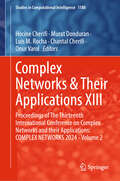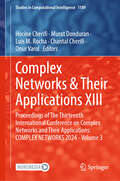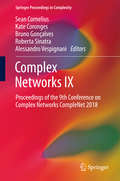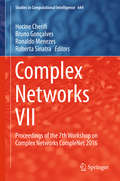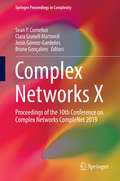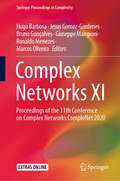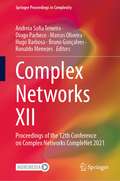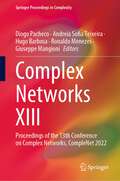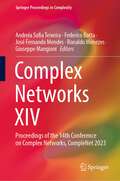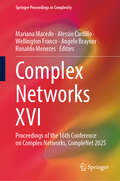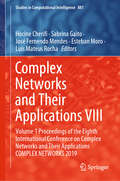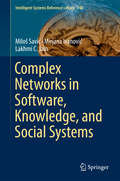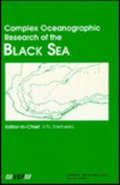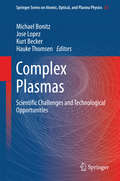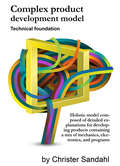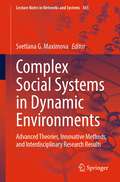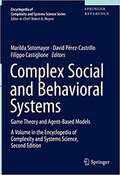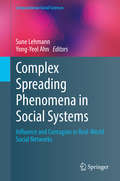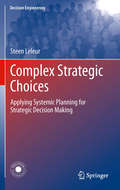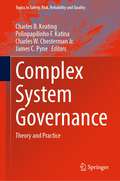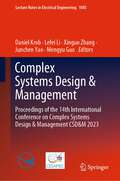- Table View
- List View
Complex Networks & Their Applications XIII: Proceedings of The Thirteenth International Conference on Complex Networks and Their Applications: COMPLEX NETWORKS 2024 - Volume 2 (Studies in Computational Intelligence #1188)
by Hocine Cherifi Chantal Cherifi Luis M. Rocha Murat Donduran Onur VarolThis book highlights cutting-edge research in network science, offering scientists, researchers, students, and practitioners a unique update on the latest advances in theory and a multitude of applications. It presents the peer-reviewed proceedings of the XIII International Conference on Complex Networks and their Applications (COMPLEX NETWORKS 2024). The carefully selected papers cover a wide range of theoretical topics such as network embedding and network geometry; community structure, network dynamics; diffusion, epidemics, and spreading processes; machine learning and graph neural networks, as well as all the main network applications, including social and political networks; networks in finance and economics; biological networks and technological networks.
Complex Networks & Their Applications XIII: Proceedings of The Thirteenth International Conference on Complex Networks and Their Applications: COMPLEX NETWORKS 2024 - Volume 3 (Studies in Computational Intelligence #1189)
by Hocine Cherifi Chantal Cherifi Luis M. Rocha Murat Donduran Onur VarolThis book highlights cutting-edge research in network science, offering scientists, researchers, students, and practitioners a unique update on the latest advances in theory and a multitude of applications. It presents the peer-reviewed proceedings of the XIII International Conference on Complex Networks and their Applications (COMPLEX NETWORKS 2024). The carefully selected papers cover a wide range of theoretical topics such as network embedding and network geometry; community structure, network dynamics; diffusion, epidemics, and spreading processes; machine learning and graph neural networks, as well as all the main network applications, including social and political networks; networks in finance and economics; biological networks and technological networks.
Complex Networks & Their Applications XIII: Proceedings of The Thirteenth International Conference on Complex Networks and their Applications: COMPLEX NETWORKS 2024 - Volume 4 (Studies in Computational Intelligence #1190)
by Hocine Cherifi Chantal Cherifi Luis M. Rocha Murat Donduran Onur VarolThis book highlights cutting-edge research in network science, offering scientists, researchers, students, and practitioners a unique update on the latest advances in theory and a multitude of applications. It presents the peer-reviewed proceedings of the XIII International Conference on Complex Networks and their Applications (COMPLEX NETWORKS 2024). The carefully selected papers cover a wide range of theoretical topics such as network embedding and network geometry; community structure, network dynamics; diffusion, epidemics, and spreading processes; machine learning and graph neural networks, as well as all the main network applications, including social and political networks; networks in finance and economics; biological networks and technological networks.
Complex Networks IX
by Alessandro Vespignani Bruno Gonçalves Roberta Sinatra Sean Cornelius Kate CorongesThis book aims to bring together researchers and practitioners working across domains and research disciplines to measure, model, and visualize complex networks. It collects the works presented at the 9th International Conference on Complex Networks (CompleNet) in Boston, MA, March, 2018. With roots in physical, information and social science, the study of complex networks provides a formal set of mathematical methods, computational tools and theories to describe, prescribe and predict dynamics and behaviors of complex systems. Despite their diversity, whether the systems are made up of physical, technological, informational, or social networks, they share many common organizing principles and thus can be studied with similar approaches. This book provides a view of the state-of-the-art in this dynamic field and covers topics such as group decision-making, brain and cellular connectivity, network controllability and resiliency, online activism, recommendation systems, and cyber security.
Complex Networks VII: Proceedings of the 7th Workshop on Complex Networks CompleNet 2016 (Studies in Computational Intelligence #644)
by Bruno Gonçalves Hocine Cherifi Ronaldo Menezes Roberta SinatraThe last decades have seen the emergence of Complex Networks as the language with which a wide range of complex phenomena in fields as diverse as Physics, Computer Science, and Medicine (to name just a few) can be properly described and understood. This book provides a view of the state of the art in this dynamic field and covers topics ranging from network controllability, social structure, online behavior, recommendation systems, and network structure. This book includes the peer-reviewed list of works presented at the 7th Workshop on Complex Networks CompleNet 2016 which was hosted by the "Universite de Bourgogne, France," from March 23-25, 2016. The 28 carefully reviewed and selected contributions in this book address many topics related to complex networks and have been organized in seven major groups: (1) Theory of Complex Networks, (2) Multilayer networks, (3) Controllability of networks, (4) Algorithms for networks, (5) Community detection, (6) Dynamics and spreading phenomena on networks, (7) Applications of Networks. "
Complex Networks X: Proceedings of the 10th Conference on Complex Networks CompleNet 2019 (Springer Proceedings in Complexity)
by Bruno Gonçalves Sean P. Cornelius Clara Granell Martorell Jesús Gómez-GardeñesThis book aims to bring together researchers and practitioners working across domains and research disciplines to measure, model, and visualize complex networks. It collects the works presented at the 10th International Conference on Complex Networks (CompleNet) in Taragona, Spain, March, 2019. With roots in physical, information and social science, the study of complex networks provides a formal set of mathematical methods, computational tools and theories to describe, prescribe and predict dynamics and behaviors of complex systems. Despite their diversity, whether the systems are made up of physical, technological, informational, or social networks, they share many common organizing principles and thus can be studied with similar approaches. This book provides a view of the state-of-the-art in this dynamic field and covers topics such as group decision-making, brain and cellular connectivity, network controllability and resiliency, online activism, recommendation systems, and cyber security. This text will appeal to students and researchers in the field.
Complex Networks XI: Proceedings of the 11th Conference on Complex Networks CompleNet 2020 (Springer Proceedings in Complexity)
by Bruno Gonçalves Ronaldo Menezes Giuseppe Mangioni Hugo Barbosa Jesus Gomez-Gardenes Marcos OliveiraThis book aims to bring together researchers and practitioners from diverse disciplines—from sociology, biology, physics, and computer science—who share a passion to better understand the interdependencies within and across systems. This volume contains contributions presented at the 11th International Conference on Complex Networks (CompleNet) in Exeter, United Kingdom, 31 March - 3 April 2020. CompleNet is a venue for discussing ideas and findings about all types of networks, from biological, to technological, to informational and social. It is this interdisciplinary nature of complex networks that CompleNet aims to explore and celebrate.
Complex Networks XII: Proceedings of the 12th Conference on Complex Networks CompleNet 2021 (Springer Proceedings in Complexity)
by Bruno Gonçalves Ronaldo Menezes Hugo Barbosa Marcos Oliveira Andreia Sofia Teixeira Diogo PachecoThis book contains contributions presented at the 12th International Conference on Complex Networks (CompleNet), 24-26 May 2021. CompleNet is an international conference on complex networks that brings together researchers and practitioners from diverse disciplines—from sociology, biology, physics, and computer science—who share a passion to better understand the interdependencies within and across systems. CompleNet is a venue to discuss ideas and findings about all types networks, from biological, to technological, to informational and social. It is this interdisciplinary nature of complex networks that CompleNet aims to explore and celebrate.
Complex Networks XIII: Proceedings of the 13th Conference on Complex Networks, CompleNet 2022 (Springer Proceedings in Complexity)
by Ronaldo Menezes Giuseppe Mangioni Hugo Barbosa Andreia Sofia Teixeira Diogo PachecoThis book contains contributions presented at the 13th International Conference on Complex Networks (CompleNet), April 19–22, 2022. CompleNet is an international conference on complex networks that brings together researchers and practitioners from diverse disciplines—from sociology, biology, physics, and computer science—who share a passion to better understand the interdependencies within and across systems. CompleNet is a venue to discuss ideas and findings about all types of networks, from biological to technological and to informational and social. It is this interdisciplinary nature of complex networks that CompleNet aims to explore and celebrate.
Complex Networks XIV: Proceedings of the 14th Conference on Complex Networks, CompleNet 2023 (Springer Proceedings in Complexity)
by Ronaldo Menezes Giuseppe Mangioni Andreia Sofia Teixeira José Fernando Mendes Federico BottaThis book contains contributions in the area of Network Science, presented at the 14th International Conference on Complex Networks (CompleNet), 24-28 April, 2023 in Aveiro, Portugal. CompleNet is an international conference on complex networks that brings together researchers and practitioners from diverse disciplines—from sociology, biology, physics, and computer science—who share a passion to better understand the interdependencies within and across systems. CompleNet is a venue to discuss ideas and findings about all types networks, from biological, to technological, to informational and social. It is this interdisciplinary nature of complex networks that CompleNet aims to explore and celebrate.The audience of the work are professionals and academics working in Network Science, a highly-multidisciplinary field.
Complex Networks XV: Proceedings of the 15th Conference on Complex Networks, CompleNet 2024 (Springer Proceedings in Complexity)
by Ronaldo Menezes Hugo Barbosa Federico Botta Mariana MacedoThe International Conference on Complex Networks (CompleNet) brings together researchers and practitioners from diverse disciplines working on areas related to complex networks. CompleNet has been an active conference since 2009. Over the past two decades, we have witnessed an exponential increase in the number of publications and research centres dedicated to this field of Complex Networks (aka Network Science). From biological systems to computer science, from technical to informational networks, and from economic to social systems, complex networks are becoming pervasive for dozens of applications. It is the interdisciplinary nature of complex networks that CompleNet aims to capture and celebrate. The CompleNet conference is one of the most cherished events by scientists in our field. Maybe it is because of its motivating format, consisting of plenary sessions (no parallel sessions); or perhaps the reason is that it finds the perfect balance between young and senior participation, a balance in the demographics of the presenters, or perhaps it is just the quality of the work presented.
Complex Networks XVI: Proceedings of the 16th Conference on Complex Networks, CompleNet 2025 (Springer Proceedings in Complexity)
by Ronaldo Menezes Mariana Macedo Alessio Cardillo Wellington Franco Angelo BraynerThis book compiles the proceedings of the 16th International Conference on Complex Networks (CompleNet 2025), a distinguished gathering that has united researchers and practitioners from diverse fields since 2009. CompleNet's interdisciplinary approach highlights the pervasive applications of complex networks across various domains, including biological, technical, informational, economic, and social systems. Known for its plenary sessions and balanced participation, CompleNet 2025 offered a platform for engaging with the latest advancements in Network Science. The chapters in this volume cover a wide array of topics, such as Computational Social Science, Dynamics on and of Networks, Ecological Networks, Epidemic Modelling, Network Algorithms, and Networked Medicine. These contributions reflect the extensive range of discussions at the conference, advancing our understanding of Network Science and its applications. A notable highlight was the panel discussion on Network Science and Responsible Artificial Intelligence, emphasizing the importance of ethical considerations in technological development. CompleNet 2025 also introduced a dedicated session for students from Ceará, fostering inclusivity and providing young researchers with invaluable exposure to international scientific discourse. This initiative aligns with CompleNet's mission to democratize access to scientific knowledge and nurture the next generation of network scientists. This proceedings is an invaluable resource for researchers, scholars, and practitioners in Network Science, Data Science, and Complex Systems. It offers a comprehensive overview of current research trends and innovations, making it essential reading for anyone interested in understanding the complexities of interconnected systems. Whether you are a seasoned researcher or a newcomer to the field, CompleNet 2025 provides insights and inspiration for exploring the dynamic world of complex networks.
Complex Networks and Their Applications VIII: Volume 1 Proceedings of the Eighth International Conference on Complex Networks and Their Applications COMPLEX NETWORKS 2019 (Studies in Computational Intelligence #881)
by Hocine Cherifi Sabrina Gaito José Fernendo Mendes Esteban Moro Luis Mateus RochaThis book highlights cutting-edge research in the field of network science, offering scientists, researchers, students, and practitioners a unique update on the latest advances in theory and a multitude of applications. It presents the peer-reviewed proceedings of the Eighth International Conference on Complex Networks and their Applications (COMPLEX NETWORKS 2019), which took place in Lisbon, Portugal, on December 10–12, 2019. The carefully selected papers cover a wide range of theoretical topics such as network models and measures; community structure, and network dynamics; diffusion, epidemics, and spreading processes; resilience and control as well as all the main network applications, including social and political networks; networks in finance and economics; biological and neuroscience networks; and technological networks.
Complex Networks and Their Applications VIII: Volume 2 Proceedings of the Eighth International Conference on Complex Networks and Their Applications COMPLEX NETWORKS 2019 (Studies in Computational Intelligence #882)
by Hocine Cherifi Sabrina Gaito José Fernendo Mendes Esteban Moro Luis Mateus RochaThis book highlights cutting-edge research in the field of network science, offering scientists, researchers, students, and practitioners a unique update on the latest advances in theory and a multitude of applications. It presents the peer-reviewed proceedings of the Eighth International Conference on Complex Networks and their Applications (COMPLEX NETWORKS 2019), which took place in Lisbon, Portugal, on December 10–12, 2019. The carefully selected papers cover a wide range of theoretical topics such as network models and measures; community structure, and network dynamics; diffusion, epidemics, and spreading processes; resilience and control as well as all the main network applications, including social and political networks; networks in finance and economics; biological and neuroscience networks; and technological networks.
Complex Networks in Software, Knowledge, and Social Systems (Intelligent Systems Reference Library #148)
by Lakhmi C. Jain Mirjana Ivanović Miloš SavićThis book provides a comprehensive review of complex networks from three different domains, presents novel methods for analyzing them, and highlights applications with accompanying case studies. Special emphasis is placed on three specific kinds of complex networks of high technological and scientific importance: software networks extracted from the source code of computer programs, ontology networks describing semantic web ontologies, and co-authorship networks reflecting collaboration in science. The book is primarily intended for researchers, teachers and students interested in complex networks and network data analysis. However, it will also be valuable for researchers dealing with software engineering, ontology engineering and scientometrics, as it demonstrates how complex network analysis can be used to address important research issues in these three disciplines.
Complex Oceanographic Research on the Black Sea
by V. N. EremeevThis book contains articles by oceanographic researchers from the (former) USSR and presents new data on various aspects of the Black Sea. The topics include Black Sea thermohaline, hydrochemical and optical structures, the dynamics of the Main Black Sea current and deep layers, wave phenomena in shelf areas and modelling of complex marine systems.
Complex Ophthalmic Dosage Forms: Advances in Biomedical Applications and Future Perspectives
by Neelesh Kumar MehraThe aim of the proposed book is to provide exhaustive information about the fundamental concepts, theory and applications of the simple and complex ophthalmic dosage forms with emphasis on the regulatory aspects of the same for formulators and academic / industrial researchers. The proposed book comprehensively covers the current research trends and industrial inputs beginning from the pharmaceutical product development strategy, composition, labelling, challenges, NDA vs ANDA filing to the advanced drug delivery approaches using novel micro and nanocarriers, fixed–dose combinations, role of preservatives in product development and so on. This book also covers various eye related disease like glaucoma, age-related macular degeneration, uveal melanoma, cataract, fungal keratitis, conjunctivitis, blindness etc. which need to be treatable. The sterile ophthalmic product development approaches inclusive of different drug delivery dosage form technologies have been revolutionary in current healthcare, pharmaceutical research and innovation. However, it has its own challenges in scale up and commercial aspects, which could be a reason for limited scope and availability of ophthalmic products in market. Development of complex sterile ophthalmic product is crucial and needs proper systematic approaches starting from pre-formulation till validation, scale up and commercialization including toxicological data. This book presents these approaches in vivid chapters contributed by renowned formulators, researchers and academician working in the fields of ophthalmic product development across the world. The primary audience for the proposed book would be academic and industrial researchers, PhD/postdoctoral research fellows, formulation scientists and bio-medical professionals. The comprehensive focus on fundamental concepts, advanced drug formulation and regulatory guidelines will benefit students as well as professionals in the field of ophthalmic medicine. This book, Complex Ophthalmic Dosage Forms: Advances in Biomedical Applications and Future Perspectives, offers a detailed overview of the latest innovations in ophthalmic drug delivery. Beginning with the fundamentals of ocular drug delivery systems and the anatomy of the eye, this book provides an exploration of drug delivery to both the anterior and posterior segments. A dedicated chapter on the fixed-dose combination approach examines its application in ocular diseases, highlighting both its therapeutic potential and associated challenges. Furthermore, the book delves into key aspects of ophthalmic product development, including reverse engineering, the role of preservatives, and the application of Quality by Design (QbD) principles. It includes discussions on the safety of nanoformulations, as well as an in-depth analysis of emerging nano-assisted platforms in ocular drug delivery, highlighting both opportunities and safety concerns. Recognizing the importance of packaging a dedicated chapter explores the critical role of sterility in ocular products, detailing sterility validation processes to ensure product safety and efficacy. This is followed by a thorough discussion on packaging, including the selection of appropriate containers and closure systems. Given that an optimized packaging system is essential for maintaining the stability, sterility, and overall quality of ophthalmic products, this section highlights key considerations in designing effective packaging solutions. Additionally, the book delves into regulatory considerations, challenges in clinical translation, and potential future developments that may redefine ophthalmic therapeutics.
Complex Plasmas: Scientific Challenges and Technological Opportunities (Springer Series on Atomic, Optical, and Plasma Physics #82)
by Michael Bonitz Jose Lopez Kurt Becker Hauke ThomsenThis book provides the reader with an introduction to the physics of complex plasmas, a discussion of the specific scientific and technical challenges they present and an overview of their potential technological applications. Complex plasmas differ from conventional high-temperature plasmas in several ways: they may contain additional species, including nano meter- to micrometer-sized particles, negative ions, molecules and radicals and they may exhibit strong correlations or quantum effects. This book introduces the classical and quantum mechanical approaches used to describe and simulate complex plasmas. It also covers some key experimental techniques used in the analysis of these plasmas, including calorimetric probe methods, IR absorption techniques and X-ray absorption spectroscopy. The final part of the book reviews the emerging applications of microcavity and microchannel plasmas, the synthesis and assembly of nanomaterials through plasma electrochemistry, the large-scale generation of ozone using microplasmas and novel applications of atmospheric-pressure non-thermal plasmas in dentistry. Going beyond the scope of traditional plasma texts, the presentation is very well suited for senior undergraduate, graduate students and postdoctoral researchers specializing in plasma physics.
Complex Product Development Model: Holistic model composed of detailed explanations for developing products containing a mix of mechanics, electronics, and programs
by Christer SandahlHave you ever tried to explain what quality is? Let's say you know perfectly well how to develop a quality product, but your arguments are undermined all the time by fragmented details. Time and again you have to step back to sort out the details, in order to make a renewed attack. But somewhere along the debate you get stuck. The details never get sorted out. There are too many of them, and you don't share their definitions. After an hour or two you give up, and you revert to the old way of working, although you know you could do so much better. Now there is a solution to your frustration. The complex product development model explains all details and puts them together into a holistic and consistent lodestar for all engineers, managers, and teachers dealing with development of products containing a mix of mechanics, electronics, and programs. This model is an update of best practices from the most applicable development models in the world, scrutinized through a lifetime of product development experience in local, regional, and international product development companies. This book explains Cpdm principles in-depth, with numerous real examples. Difficulties and complexities are illustrated by a wealth of drawings, figures, and tables. You can go back and forth to understand every aspect. Over a product's life cycle, development cost is seldom significant. Development time is sometimes important, but most often the crucial shortage lies in quality, capability, and predictability. The Cpdm toolbox is available—use it to win your debates and start to improve this industry forever.
Complex Social Systems in Dynamic Environments: Advanced Theories, Innovative Methods, and Interdisciplinary Research Results (Lecture Notes in Networks and Systems #365)
by Svetlana G. MaximovaThis edited book considers social systems as self-organizing structures that reproduce new structural elements endowed with certain functional connections. The authors analyze innovative processes in social systems, leading to the sustainable convergence of knowledge and the emergence of technologies that improve the level of material well-being in society. The book summarizes research results in the field of digitalization and reveals deep connections with social problems. In addition, the book presents a whole array of innovative research on social systems management and the application of knowledge and intelligence to the solution of social problems. The contributing scholars and practitioners reflect on various types of social systems and assess the influence of disruptive factors from natural and coupled human-natural environments, discussing possible mechanisms for their neutralization. Sustainable development of social systems is among the most important tasks facing the contemporary world. The contributed book highlights challenges to the sustainability of social systems, draws sociotechnical images of the future world order generated by the rapid development of intellectual technologies, and critically analyzes promising concepts for more sustainable social future. Among the discussed topics in the book are social governance, digital economy, technological landscapes, social systems modeling and simulation, cyber-social systems, knowledge-based innovation systems, complex processes in social systems, institutional arrangements, and other advancing research areas. The high-quality and original studies presented in the book appeal to those interested in broadening their perspectives on complexity science, complex social systems research, complex systems management, advanced technological development in social systems, etc. Since the book is rich with well-thought theories, advanced research approaches, and interdisciplinary research results, it becomes a great source of new ideas and insights on complex social systems.
Complex Social and Behavioral Systems: Game Theory and Agent-based Models (Encyclopedia of Complexity and Systems Science)
by Filippo Castiglione Marilda Sotomayor David Perez-CastrilloThis volume in the Encyclopedia of Complexity and Systems Science, Second Edition, combines the main features of Game Theory, covering most of the fundamental theoretical aspects under the cooperative and non-cooperative approaches, with the procedures of Agent-Based Modeling for studying complex systems composed of a large number of interacting entities with many degrees of freedom. <p><p>In Game Theory, the cooperative approach focuses on the possible outcomes of the decision-makers’ interaction by abstracting from the "rational" actions or decisions that may lead to these outcomes. The non-cooperative approach focuses on the actions that the decision-makers can take. As John von Neumann and Oskar Morgenstern argued in their path-breaking book of 1944 entitled Theory of Games and Economic Behavior, most economic questions should be analyzed as games. The models of game theory are abstract representations of a number of real-life situations and have applications to economics, political science, computer science, evolutionary biology, social psychology, and law among others. Agent-Based Modeling (ABM) is a relatively new computational modeling paradigm which aims to construct the computational counterpart of a conceptual model of the system under study on the basis of discrete entities (i.e., the agent) with some properties and behavioral rules, and then to simulate them in a computer to mimic the real phenomena. Given the relative immaturity of this modeling paradigm, and the broad spectrum of disciplines in which it is applied, a clear cut and widely accepted definition of high level concepts of agents, environment, interactions and so on, is still lacking. <p><p>This volume explores the state-of-the-art in the development of a real ABM ontology to address the epistemological issues related to this emerging paradigm for modeling complex systems.
Complex Spreading Phenomena in Social Systems: Influence and Contagion in Real-World Social Networks (Computational Social Sciences)
by Yong-Yeol Ahn Sune LehmannThis text is about spreading of information and influence in complex networks. Although previously considered similar and modeled in parallel approaches, there is now experimental evidence that epidemic and social spreading work in subtly different ways. While previously explored through modeling, there is currently an explosion of work on revealing the mechanisms underlying complex contagion based on big data and data-driven approaches.This volume consists of four parts. Part 1 is an Introduction, providing an accessible summary of the state of the art. Part 2 provides an overview of the central theoretical developments in the field. Part 3 describes the empirical work on observing spreading processes in real-world networks. Finally, Part 4 goes into detail with recent and exciting new developments: dedicated studies designed to measure specific aspects of the spreading processes, often using randomized control trials to isolate the network effect from confounders, such as homophily. Each contribution is authored by leading experts in the field. This volume, though based on technical selections of the most important results on complex spreading, remains quite accessible to the newly interested. The main benefit to the reader is that the topics are carefully structured to take the novice to the level of expert on the topic of social spreading processes. This book will be of great importance to a wide field: from researchers in physics, computer science, and sociology to professionals in public policy and public health.
Complex Strategic Choices: Applying Systemic Planning for Strategic Decision Making (Decision Engineering)
by Steen LeleurEffective decision making requires a clear methodology, particularly in complex, globally relevant situations. Institutions and companies in all disciplines and sectors are faced with increasingly multi-faceted areas of uncertainty which cannot always be effectively handled by traditional strategies. Complex Strategic Choices provides clear principles and methods which can guide and support strategic decision to face modern challenges. By considering ways in which planning practices can be renewed and exploring the possibilities for acquiring awareness and tools to add value to strategic decision making, Complex Strategic Choices presents a methodology which is further illustrated by a number of case studies and example applications. Dr. Techn. Steen Leleur has adapted previously established research based on feedback and input from various conferences, journals and students resulting in new material stemming from and focusing on practical application of systemic planning. The outcome is a coherent and flexible approach named systemic planning. The inclusion of both the theoretical and practical aspects of systemic planning makes this book a key resource for researchers and students in the field of planning and decision analysis as well as practitioners dealing with strategic analysis and decision making. More broadly, Complex Strategic Choices acts as guide for professionals and students involved in complex planning tasks across several fields such as business and engineering.
Complex System Governance: Theory and Practice (Topics in Safety, Risk, Reliability and Quality #40)
by Polinpapilinho F. Katina Charles B. Keating Charles W. Chesterman Jr. James C. PyneThis book explores Complex System Governance (CSG)—an emerging field concerned with the design, execution, and evolution of essential functions necessary to ensure continued viability of a system. The book focuses on three primary development areas to better understand and utilize current developments CSG. First, the conceptual foundations for CSG are developed, from systems theory, management cybernetics, and governance. Second, a set of critical CSG topics are examined from conceptual as well as practice perspectives. Third, several development and application issues are discussed. Ultimately, CSG is positioned as an emerging field with strong theoretical grounding and significant implications for improving practices and performance to better address complex systems and their problems.
Complex Systems Design & Management: Proceedings of the 14th International Conference on Complex Systems Design & Management CSD&M 2023 (Lecture Notes in Electrical Engineering #1085)
by Daniel Krob Xinguo Zhang Lefei Li Junchen Yao Mengyu GuoThis book contains all refereed papers accepted during the 14th International Conference on Complex Systems Design & Management CSD&M 2023 that took place in Beijing, People’s Republic of China by the end October 2023. Mastering complex systems requires an integrated understanding of industrial practices as well as sophisticated theoretical techniques and tools. This explains the creation of an annual go-between European and Asian forum dedicated to academic researchers and industrial actors working on complex industrial systems architecting, modeling and engineering. These proceedings cover the most recent trends in the emerging field of complex systems, both from an academic and professional perspective. A special focus was put this year on “New Trends in Complex Systems Engineering.” The CSD&M series of conferences were initiated under the guidance of CESAM Community in Europe, managed by CESAMES. Its Asian version took place in Singapore for three consecutive sessions during 2014 and 2018. The fourth Asian edition was held in Beijing in hybrid with the Chinese Society of Aeronautics and Astronautics (CSAA) as the co-organizer in 2021. Since 2023, its European and Asian conferences merge into one, taking place in China and Europe in turn. CESAM Community aims in organizing the sharing of good practices in systems architecting and model-based systems engineering (MBSE) and certifying the level of knowledge and proficiency in this field through the CESAM certification. The CESAM systems architecting, and model-based systems engineering (MBSE) certification is especially currently the most disseminated professional certification in the world in this domain through more than 3,000 real complex system development projects on which it was operationally deployed and around 10,000 engineers who were trained on the CESAM framework at international level.
